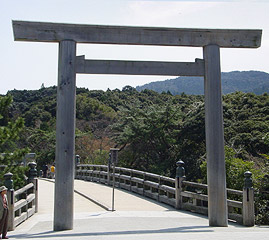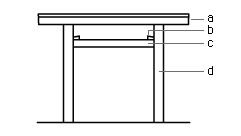Gateways
*torii ¹, specific
to Ise Jinguu Éš_{, of which there are two types. Both are called ise
torii and both are related to *shinmei
torii _Ÿ¹ but have certain characteristics which set them apart.
The ise torii are to be found in the two sanctuaries,
Naikuu à{ (the Inner Shrine) and Gekuu O{ (the Outer Shrine). With the exception of the four
torii attached to the four outermost concentric fences which surround
the inner sanctuaries of the Naikuu and Gekuu, all the other torii
are of the same style. The torii at either end of the Uji F¡ Bridge
at the Naikuu exemplify the style closest to the shinmei torii. However,
the circular pillars have a noticeable inward incline *uchikorobi
à]. The rectangular tie beam *nuki
Ñ, is secured by wedges *kusabi
¶, inserted on the inner faces of the pillars. As with the shinmei torii
tie beams, the Uji Bridge tie beams do not extend beyond the outer faces
of the pillars. The top lintel *kasagi
}Ø, is a heavy beam, but unlike the shinmei torii top lintel, all
the ise torii are pentagonal in section. The upper surface of each end of
the torii has a very slight and almost in perceptible thickening at
the ends giving the impression of a curve and an inward slanting cut on
each end *tasukizumi
æFn. Torii of this type also include the First and Second torii; Ichi-no-torii ê̹, Ni-no-torii ñ̹, at both Naikuu and Gekuu, and the
middle torii, called Nakanoe-no-torii d¹. This is the pillar between
the second and third fences within the sacred precinct at both the Naikuu
and Gekuu. None of these three torii existed before the 14c. The
second type of ise torii can be seen on the south side of the outermost
fence, itagaki Â_, which is itself attached to the exterior of each
circular pillar. The pillars have a slight inward incline. The tie beam,
secured by wedges, is exactly the same as the above described torii.
However, these pillars have both secondary and top lintels *shimaki
Ø and kasagi. The secondary lintel is a flat, broad, straight,
heavy, rectangular beam, that is greater in width than the diameter of the
pillars. The rectangular top lintel is set up on its narrow face and extends
beyond the end of the secondary lintel. The undersides are straight, but
there is an almost imperceptible thickening from bottom to top on each end
of the top lintel which creates the same very slight upward curve seen on
all ise torii. The top lintel is pentagonal in section. All the torii
are made of wood and are replaced every twenty years, as are all the buildings
of the inner precincts of both the Naikuu and Gekuu, as well as several
other buildings not within the most sacred areas.
|




